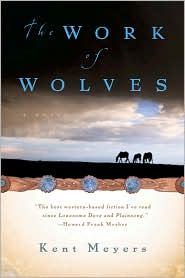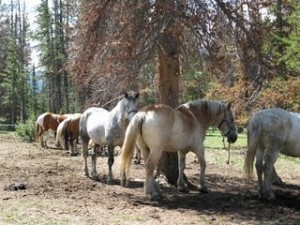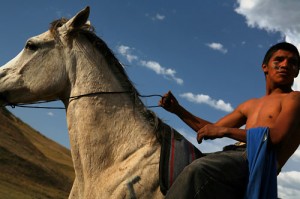Note: This novel was WINNER of an Alex Award for 2005.
“We’re doing the work of wolves. They ain’t here to do it. We got to do it for them.”
In a powe rful opening scene, fourteen-year-old Carson Fielding, of Twisted Tree, South Dakota, approaches Magnus Yarborough, the slickest and wealthiest man in town, and negotiates to buy a horse. He is already an accomplished horse trainer, but he has a limited budget. Nevertheless, he picks out the best of the horses in his price range and refuses to budge on his offering price until he succeeds in getting the horse. Twelve years later, when Carson is broke and the family ranch is in trouble, he takes a job training some of Yarborough’s horses and teaching his wife to ride. Though he succeeds in accomplishing both of these goals, too, he makes a permanent enemy of Yarborough this time.
rful opening scene, fourteen-year-old Carson Fielding, of Twisted Tree, South Dakota, approaches Magnus Yarborough, the slickest and wealthiest man in town, and negotiates to buy a horse. He is already an accomplished horse trainer, but he has a limited budget. Nevertheless, he picks out the best of the horses in his price range and refuses to budge on his offering price until he succeeds in getting the horse. Twelve years later, when Carson is broke and the family ranch is in trouble, he takes a job training some of Yarborough’s horses and teaching his wife to ride. Though he succeeds in accomplishing both of these goals, too, he makes a permanent enemy of Yarborough this time.
Carson’s view of the world—limited to horses, the ranch, what he has learned from his late grandfather, and his recent discovery of love—changes when he is contacted by Earl Walks Alone, a Lakota teenager, and Willi Schubert, a foreign exchange student from Germany, asking for help. Earl, a senior in high school, with lofty goals for the future, has observed something strange during a night-time party in the hills, something he knows he is not supposed to have seen. Off in the distance, hidden from all roads, is a small holding pen containing three emaciated horses, with no food, cool water, or shelter.
 Knowing that Carson is an expert on horses, Earl has contacted him with questions, and when Earl, Carson, and Willi investigate the mysterious horses, Carson is stunned. He knows, as the others do not, that these horses belong to Magnus Yarborough, and he suddenly understands also why these animals are being tortured. Along with Ted Kills Many, an alcoholic Lakota in his late twenties, the four decide to rescue the horses and to do it in the spirit of Iktomi, the trickster of Indian lore. “A good thief creates disbelief,” Earl’s uncle Norm tells him. “A good thief makes a man believe—just for a moment—that horses can fly.”
Knowing that Carson is an expert on horses, Earl has contacted him with questions, and when Earl, Carson, and Willi investigate the mysterious horses, Carson is stunned. He knows, as the others do not, that these horses belong to Magnus Yarborough, and he suddenly understands also why these animals are being tortured. Along with Ted Kills Many, an alcoholic Lakota in his late twenties, the four decide to rescue the horses and to do it in the spirit of Iktomi, the trickster of Indian lore. “A good thief creates disbelief,” Earl’s uncle Norm tells him. “A good thief makes a man believe—just for a moment—that horses can fly.”
Though the rescue of the horses controls the action of the novel, that rescue is more important symbolically than in real-time. Each of the four young men has special reasons for identifying with the plight of these animals, reasons connected to their pasts and their understanding of how man and nature are related. Carson has only recently discovered the depth of cruelty possible in men like Magnus Yarborough, whose desire for power extends toward animals as well as men. Earl Walks Alone, accustomed to prejudice against Indians, is all too aware that the conditions on the reservation and the hopelessness of its inhabitants are related to their loss of connection to the earth, but he himself wants to leave for college and he feels guilty about this.
Willi Schubert, who belonged to an “Indianer Club” in Germany, where during the previous summer he camped in tipis and tried to live an Indian life, has discovered that not only was his grandfather a Nazi responsible for sending Jews to their deaths, but that his grandmother still believes in Hitler’s goals. Ted Kills Many leads a subsistence life on the reservation, where he does nothing, simply living and letting live, and drinking when he wants to. In their mission to save the horses, all come to important understandings about themselves and their connection to each other, to nature, to their families, and to the wider world.
belonged to an “Indianer Club” in Germany, where during the previous summer he camped in tipis and tried to live an Indian life, has discovered that not only was his grandfather a Nazi responsible for sending Jews to their deaths, but that his grandmother still believes in Hitler’s goals. Ted Kills Many leads a subsistence life on the reservation, where he does nothing, simply living and letting live, and drinking when he wants to. In their mission to save the horses, all come to important understandings about themselves and their connection to each other, to nature, to their families, and to the wider world.
Meyers creates much more than a coming-of-age story here, delving into the essence of life itself, while keeping his style unpretentious and his plot lines simple. Throughout the novel, it is the stories the characters learn from their parents, grandparents, aunts, and uncles which connect the various themes, unite the characters, and show the overlaps between cultures. As the young characters recall these stories and hear new ones, they also understand that underlying all stories are dreams, some living and some destroyed, some  emanating from higher powers and some coming from within. Featuring characters with whom the reader identifies, and filled with realistic details about farming, ranching, and everyday life, past and present, this rich novel stretches our imagination, challenges our thinking, and keeps us totally entertained every step of the way. (The top of my Favorites list for 2005.)
emanating from higher powers and some coming from within. Featuring characters with whom the reader identifies, and filled with realistic details about farming, ranching, and everyday life, past and present, this rich novel stretches our imagination, challenges our thinking, and keeps us totally entertained every step of the way. (The top of my Favorites list for 2005.)
Notes: Also reviewed here: Meyers’s TWISTED TREE
The author’s photo accompanies a story about new prizes won by his second novel, Twisted Tree: http://www.bhsu.edu
The horses in the woods are from http://wwwmorningsminion.blogspot.com
The photo of the boy on the horse is a prize-winning photo by Aaron Huey, Atlas Press, entitled “In The Shadow of Wounded Knee: Life on the Pine Ridge Indian Reservation.” The competition was sponsored by Pictures of the Year International: http://www.poyi.org The Lakota Pine Ridge Reservation in South Dakota was the site of the 1890 Massacre at Wounded Knee, in which 150 Lakota men, women, and children were shot dead on their own land, and fifty-one were wounded, some of whom later died. Thirty-one soldiers died.
